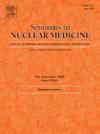Advances in Endocrine Tumor PET Imaging Targeting CXCR4 and GLP-1
IF 5.9
2区 医学
Q1 RADIOLOGY, NUCLEAR MEDICINE & MEDICAL IMAGING
引用次数: 0
Abstract
Molecular imaging has experienced significant advances in the areas of imaging probes and technology, enabling the detection of tumors at earlier stages and more accurately identifying extent of disease. To better characterize lesions, nuclear medicine modalities utilize molecular imaging agents targeting specific pathways and cell surface molecules to improve both sensitivity and specificity. In the field of endocrinology, tumors encompass a wide spectrum of aggressiveness ranging from indolent, well differentiated tumors to highly aggressive cancers. Thus, in recent years, new molecular imaging biomarkers have been developed for noninvasively assessing different types of hormone-producing tumors. For instance, 68Ga-PentixaFor is a novel PET imaging agent targeting the C-X-C chemokine receptor type 4 (CXCR4) with proven utility in various malignancies, and has also shown multifunctionality in detecting endocrine pathologies, such as primary aldosteronism, adrenocorticotropic hormone (ACTH)-producing pituitary adenomas and ACTH-independent cortisol-producing adrenal adenomas. Another novel receptor-targeted radiotracer using the glucagon-like peptide-1 receptor (GLP-1R) analog, Exendin-4 has recently developed to preoperatively localize insulinomas, arising from pancreatic beta cells. This review presents an overview of new developments and potential clinical implementation of CXCR4- and Exendin- based radiotracers for imaging applications in endocrinology.
靶向CXCR4和GLP-1的内分泌肿瘤PET成像研究进展
分子成像在成像探针和技术领域取得了重大进展,能够在早期阶段检测肿瘤并更准确地确定疾病的程度。为了更好地表征病变,核医学模式利用靶向特定途径和细胞表面分子的分子显像剂来提高灵敏度和特异性。在内分泌学领域,肿瘤涵盖了广泛的侵袭性,从惰性的、分化良好的肿瘤到高度侵袭性的肿瘤。因此,近年来,新的分子成像生物标志物已经被开发出来,用于无创评估不同类型的激素产生肿瘤。例如,68Ga-PentixaFor是一种针对C-X-C趋化因子受体4型(CXCR4)的新型PET显像剂,已被证明在各种恶性肿瘤中具有实用价值,并且在检测内分泌病变(如原发性醛固酮增多症、促肾上腺皮质激素(ACTH)产生的垂体腺瘤和不依赖促肾上腺皮质激素产生的肾上腺腺瘤)方面也显示出多种功能。另一种新型受体靶向放射性示踪剂使用胰高血糖素样肽-1受体(GLP-1R)类似物Exendin-4,最近被开发用于术前定位胰岛细胞产生的胰岛素瘤。本文综述了基于CXCR4和Exendin的放射示踪剂在内分泌成像中的新进展和潜在的临床应用。
本文章由计算机程序翻译,如有差异,请以英文原文为准。
求助全文
约1分钟内获得全文
求助全文
来源期刊

Seminars in nuclear medicine
医学-核医学
CiteScore
9.80
自引率
6.10%
发文量
86
审稿时长
14 days
期刊介绍:
Seminars in Nuclear Medicine is the leading review journal in nuclear medicine. Each issue brings you expert reviews and commentary on a single topic as selected by the Editors. The journal contains extensive coverage of the field of nuclear medicine, including PET, SPECT, and other molecular imaging studies, and related imaging studies. Full-color illustrations are used throughout to highlight important findings. Seminars is included in PubMed/Medline, Thomson/ISI, and other major scientific indexes.
 求助内容:
求助内容: 应助结果提醒方式:
应助结果提醒方式:


